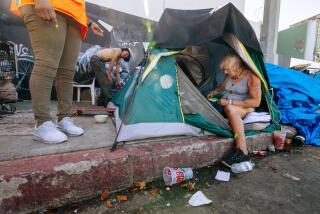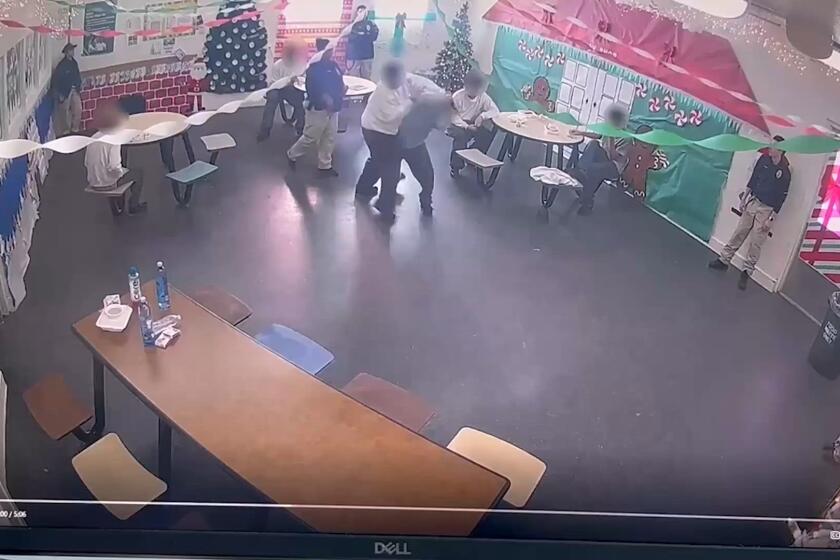Garcetti says L.A. can end street homelessness in a decade

The timetable comes amid rising public anger over City Hall’s failure to solve the crisis
- Share via
Los Angeles Mayor Eric Garcetti knows the perils of offering bold pronouncements about taming homelessness in L.A.
During his first mayoral campaign in 2013, he vowed to end chronic homelessness. Once in office, Garcetti said he would find housing for the city’s homeless veterans, first by 2015 and then 2016, before scrapping a timeline altogether.
Garcetti now seeks to cut the city’s “unsheltered” population in half in the next five years and reduce it to “functional zero” by 2028 — the final year of funding from the Measure H and Proposition HHH ballot measures, spokeswoman Anna Bahr said this week.
“The mayor set goals that establish a realistic timeline to end homelessness,” Bahr said in an email.
Functional zero means that there will “always be people who are homeless or at risk of becoming homeless,” but they are quickly identified and provided housing, Bahr said.
Bahr said the mayor established the goals last fall. But they drew little notice until he began discussing them at public events this year. Some City Council members said Tuesday they were unaware of the target dates.
The mayor’s timetable comes at a crucial moment, as public anger is rising over why City Hall has failed to make more progress in solving the crisis.
The city and the county are beginning to spend the voter-approved funds on new homeless housing and services, but encampments remain a fact of life in neighborhoods throughout the city.
Garcetti is talking about the goals as he considers a run for president in 2020. If he runs, the grim conditions on L.A. streets could be a political liability.
The unsheltered population in Los Angeles — those living on the street — is 25,237, according to the latest count. Garcetti aims to get 12,500 of that group into shelter or housing by 2022 — the year Garcetti’s tenure as mayor would end because of term limits.
“We can cut this problem in half in five years. And in 10 years … we can end life on the street,” Garcetti said in January at the beginning of the annual homeless count.
Bahr said Garcetti has made public statements regularly about his goals for cutting the unsheltered population, noting that he has been quoted in The Times about the timetable.
Councilmen Mike Bonin, Mitchell Englander and Mitch O’Farrell said Tuesday they hadn’t heard about the plan.
“I haven’t been updated,” O’Farrell said of the mayor’s targets.
“Goals are laudable,” Englander said.
Establishing a timeline for solving homelessness is not new for Los Angeles politicians.
More than a decade ago, when he was a councilman, Garcetti served with then-Mayor Antonio Villaraigosa and then-county Supervisor Zev Yaroslavsky on a panel for Bring Los Angeles Home, a plan to end homelessness in 10 years.
In another ambitious proposal, Los Angeles County supervisors announced a $100-million initiative that included opening regional shelters for the homeless. The shelter part of the plan was shelved in 2007.
In 2014, Garcetti offered a full-throated pledge to end veterans homelessness. He appeared alongside then-First Lady Michelle Obama, accepting the Obama administration’s challenge to tackle the problem — an event that generated headlines.
Kerry Morrison, who has led efforts to address homelessness in Hollywood and serves as executive director of the Hollywood Property Owners Alliance, said she didn’t know about the new timeline until contacted by The Times this week but praised Garcetti’s decision to set goals.
“It gives you something to work for,” Morrison said.
She said in a recent interview that the mayor is generally being more assertive and vocal about the homelessness crisis compared with a year ago.
“We were having a hard time getting people to talk about it,” Morrison said. “I’ve been here for 20 years, so I have the credibility to say, ‘It has never been this bad.’ ”
The pitfalls of optimistic pronouncements about homelessness are illustrated in the Los Angeles Homeless Services Authority’s 2016 analysis of how much new housing would be needed to attain functional zero.
Under the best scenario, the analysis found, thousands would be homeless at any point because of the growing influx of newly destitute people. Also, it takes a long time — an average of three months — for a homeless person to obtain housing in the area’s tight market, the report said.
“Fully meeting the housing gaps detailed in this report would only be able to lower the [homeless count] below 15,000,” the report concluded.
Even that unvarnished projection, based on the 2016 assumption that the homeless population could be reduced by 14% annually, turned out to be unrealistic. From 2015 to 2017, homelessness rose more than 30% in the city.
Chastened by the discrepancy, the agency included no projections when it updated the analysis this year.
Whether the mayor is able to achieve his goals hinges on the success of the county’s rollout of funds raised through Measure H. The city is unable to tackle homelessness on its own, city leaders have acknowledged.
Los Angeles County Supervisor Mark Ridley-Thomas, who has worked closely with the mayor on homelessness, didn’t respond to a request Tuesday for comment on Garcetti’s timeline.
Bahr said the mayor’s long-term plan includes relying on general fund dollars, money from Measure H and Proposition HHH, and private and philanthropic funds.
In addition, his “short-term strategy centers on erecting as many emergency shelters as possible near homeless encampments across Los Angeles,” including one in a parking lot near El Pueblo de Los Angeles, Bahr said.
Philip Mangano, former homelessness czar for President George W. Bush and president of the American Round Table to Abolish Homelessness, last year called Garcetti’s two yardsticks for ending veterans homelessness a “well-intentioned misjudgment.”
However, on Tuesday, he called the mayor’s latest goals “ambitious.” He said their success would be contingent on building enough housing so people aren’t just shuttled between shelters.
“He is putting himself on the front line of another numerical commitment, which has proven to be very difficult to keep in general in Los Angeles,” he said.
Twitter: @dakotacdsmith
Twitter: @latdoug
More to Read
Sign up for Essential California
The most important California stories and recommendations in your inbox every morning.
You may occasionally receive promotional content from the Los Angeles Times.












